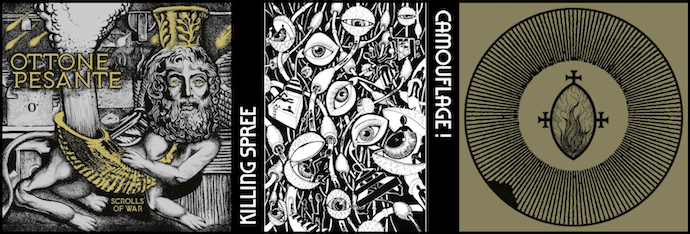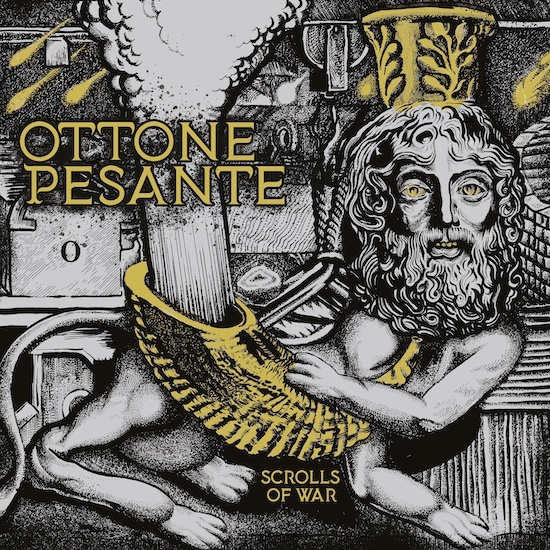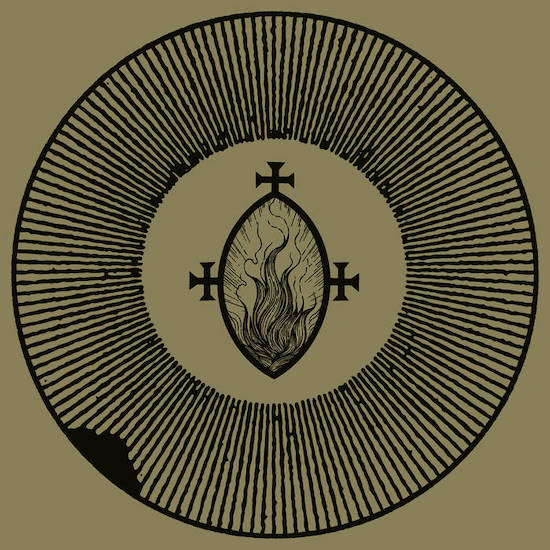
For the last few installments of this list I haven’t had any organizing principle that guided the grouping of songs together in a specific Part. Today I do. But I’m afraid if I tell you why I put these three songs together you might not listen to them (if you haven’t already heard them). Better for you to learn for yourselves, and hopefully to find yourselves as enthusiastic about them as I am.
(To find and listen to all the preceding songs in this list, use this link.)

OTTONE PESANTE
I’m going to crib from what I wrote when I first saw and heard the video for Ottone Pesante‘s “Battle of Qadesh“:
As I hope you know by now, from discovering this band either in previous features at NCS or elsewhere, they use metal to make metal, and by that I mean they bring the brass. Their new album is named Scrolls of War, and they’ve introduced it with these words:
There was a time long ago when droughts, famines, earthquakes, floods, and epidemics occurred almost simultaneously, within a very short period, forcing peoples to migrate for survival. These mass movements were desperate and caused atrocious and extremely violent wars. The ancients sanctified these wars in the name of a god leading them to victory, delivering the so-called “rules of war.” Priests were in charge of announcing the movements of the army to the sound of their trumpets and horns.
The first single from the album is named “Battle of Qadesh“. The Font of All Human Knowledge tells us that the Battle of Qadesh “took place in the 13th century BC between the Egyptian Empire led by pharaoh Ramesses II and the Hittite Empire led by king Muwatalli II,” and occurred “along what is today the Lebanon–Syria border.” That same source reports that “[i]t is believed to be the largest battle ever fought involving chariots, numbering at a total of 5,000 to 6,000,” and that it “is considered to have ended in a stalemate.”
The beautifully made video accompanying the song seems calculated to make the point that nothing changes. We can see cave drawings of ancient conflicts, and millennia later we can watch video of war in Ukraine and Gaza. Humanity seems destined to continually stalemate itself, drenched in blood. (The video portrays other interesting juxtapositions of antiquity and modernity, but I won’t spoil those by describing them.)
The song itself is a slow build. We’re ushered into it by the persistent throb of trumpets, a throb that never completely vanishes but only becomes more feverish when it reappears. It’s gradually joined by other instrumentation, including vivid drumbeats, distorted droning tones, and warbling wails that grow increasingly piercing. (Ottone Pesante coax a lot of variable sounds from trumpet and trombone.)
Tension and vigor build in the music until the band’s guest Lili Refrain appears, with her extraordinary voice adding another order of magnitude of shattering emotional intensity, backed by sweeping waves of desperate music and stunning drumwork.
It’s really a breathtaking experience. (Scrolls of War is the first album of a concept trilogy about the history of brass music.)
https://ottonepesante.bandcamp.com/album/scrolls-of-war
http://www.ottonepesante.it/
https://www.facebook.com/ottonepesante/

KILLING SPREE
I discovered this next duo through their fascinating cover of Morbid Angel‘s “Rapture,” which arrived in the company of a great video of their performance filmed in the historic trenches of the Maginot Line in Alsace. I went on and on and on about the song and the video in one of my Seen and Heard roundups last August.
Later, I had a chance to see what drummer Grégoire Galichet and saxophonist/vocalist Matthieu Metzger could cook up on their own (though that cover song is far from a straight-forward copy of the original). What I found was another video, also filmed in the Maginot Line tunnels, for the title song from their 2024 Camouflage!. Here’s what I wrote at that time:
I’m a fan of the saxophone and have always enjoyed hearing its participation in metal music. But even if you’re not a fan, don’t worry, because for the most part Matthieu Metzger contorts and distorts its sound so that you’d have trouble guessing what should be held accountable for all the savagely mangling, mercurially swirling, monstrously blurting, and crazily bleating sensations. (Before the end, in some of the song’s most freaked-out passages, I started thinking of King Crimson‘s “21st Century Schizoid Man”, which is intended as high praise).
Grégoire Galichet is also one hell of a good drummer, and more than holds his own in this wild ride (he makes the ride even wilder). There aren’t many vocals in this track, but they’re authentically bestial. And just in case you think the song is just a bizarre head-spinner, Killing Spree also pick their moment to sledgehammer the listener six feet into the ground.
Needless to say, I also found this wild ride to be a very infectious one.
P.S. I used to think a saxophone is a brass instrument, because it’s made of metal, but it’s not. It’s a member of the woodwind family — like another instrument that plays a role in the third song today.
https://resistantsrecords.bandcamp.com/album/camouflage
https://orcd.co/killing_spree_camouflage
https://www.facebook.com/killingspreetrio

PONTE DEL DIAVOLO
In years preceding 2024 I wrote several times about the music of the very interesting Italian band Ponte Del Diavolo, but last year it was my friend Andy Synn who put digital pen to digital paper to discuss their latest album Fire Blades From the Tomb.
In that discussion he began by admitting that he has “a real soft spot for bands who take a more esoteric and eccentric approach to the more familiar formulations of extreme music,” which was part of the explanation for his attraction to the album. It’s a sentiment I share, which I guess is quite obvious from the three songs I picked for this Part of my list.
The voice of the band’s frontwoman Erba del Diavolo is a key factor in the distinctive character of their music. It’s unconventional in metal circles, even in the circles of occult-ish doom metal that feature female singers, but her range of styles and moods is striking (and sometimes even jarring). Also unconventional is the band’s deployment of two bassists and the range of sounds they coax from their instruments along the quirky and often sinister pathways their songs tend to follow.
But the Ponte Del Diavolo song I’ve picked for this list includes yet another unconventional ingredient: a guest performance by Vittorio Sabelli on the clarinet (hopefully you will recognize his name from the works of Dawn of a Dark Age, Notturno, or Incantvm). When Andy wrote about the album he highlighted “the juxtaposition of seething intensity and sombre introspection which makes ‘Nocturnal Veil‘ such a captivating, creatively challenging, listen.”
To create those juxtaposing sensations Ponte Del Diavlo use frantically quivering riffage, hammering percussive gallops and stomps, and extravagantly soaring wails, as well as doses of slashing and spearing fretwork and banshee-like snarls. But the slow warbling tones of Sabelli‘s clarinet are what creates the contrasting mood of somber (and eerie) introspection.
Out of many riveting and often head-spinning songs on the album, this is the one that has pulled me back most often.
https://pontedeldiavolo666.bandcamp.com/album/fire-blades-from-the-tomb
https://www.facebook.com/PontedelDiavolo/
